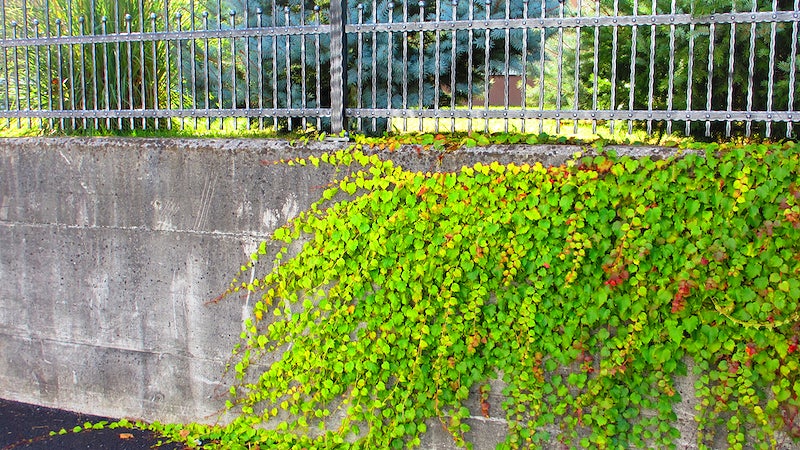
The Complete Guide to Installing a Fence on a Retaining Wall
Ideally, when you need to install a fence, you’ll have a nice flat fence line that’s easy to dig, so you can dig and pour concrete for your posts easily.
However, having been in the fence business for decades, I can say with confidence that very few fence projects meet all our ideal expectations. Very often, you’re left wondering about things like installing a fence on a retaining wall. Here’s what you need to know to get your fence built, even in this challenging situation.
1. Make Sure the Wall Can Support Your Fence
Retaining walls come in all shapes, sizes, and designs, and they can be made from all kinds of materials, including brick, concrete, concrete block or cinder block, and even wood. Not all retaining walls can support a fence, and if your retaining wall is showing signs of wear and tear or has visible structural issues, you probably want to address those first.
Even if your retaining wall can’t support a fence but is still structurally sound, you should be able to install your fence just inside the retaining wall using offset concrete bases or even by pounding or vibrating your fence posts carefully.
Let the retaining wall dictate what kind of installation you plan. This is not something you can force!
If your retaining wall has a precast coping of some kind, you will not be able to install your fence on top of it. You will need to adjust your design to either remove sections of the coping or choose a side-plated post option.
2. Get Base Plated Posts
If your retaining wall passes the structure test, and you can install your fence on top of the wall instead of next to it, the next thing you will need to do is source base-plated posts for your fence.
Most fence systems can be installed with base-plated posts instead of posts planted in concrete bases, but you do need to check with the fence supplier or manufacturer to ensure your chosen fence system has this option available.
Some fence systems might need to have base-plated posts manufactured on demand, so make sure you allow extra time for that.
Also, remember that if you need something different for your base plates, like side-plated posts or angle baseplates, you will probably have a longer wait.
You can read more about types of baseplate in our article about fence base plate design.
3. Choose the Right Fasteners
|
The next thing you will need to do when installing a fence on a retaining wall is to choose the right fasteners for the job. In most cases, mechanical expansion bolts like wedge anchors or sleeve anchors will do the job adequately, but if you are installing a very heavy fence or you have high wind, and you want to be extra sure, a chemical anchor might be a better choice. Speak to a bolt or fastener specialist to determine the best type and size of bolt or anchor for your retaining wall fence. |
4. Don’t Forget Fall Protection!
Once you’ve got your fence posts and material and chosen your bolts and fasteners, you’re about ready to start planning the installation of your fence on top of the retaining wall. At this point, you want to consider the height of the retaining wall and whether you need to have fall protection during the fence installation.
Remember that regulations about work at elevated positions usually take the lowest point as ground level, and depending on the height of your retaining wall, you may need to use fall protection and other PPE to keep your installers safe during the fence installation process.
5. Be Careful While Drilling
If you’re installing a base-plated fence on a retaining wall, you’re going to need to drill holes for your bolts and fasters. Be sure to keep your holes far enough away from the edge of the wall so that you don’t damage or crack it, and approach each hole with care.
Remember that fence companies usually don’t accept liability for damage caused to walls due to existing or latent defects in the wall, so if they do crack or damage your wall during the installation, you might have to pay extra for repairs or do them yourself. That doesn’t mean they shouldn’t exercise care during the installation, but they also didn’t build the wall and can’t predict what might happen when they start your fence installation.
6. Dealing with Steps
One of the challenges of installing a fence on a retaining wall is that, very often, retaining walls step to follow the ground level, and any changes in elevation on a fence are a challenge.
When you’re installing a fence on a retaining wall, the easiest way to approach this is to simply install longer posts at the step and then install your next section of fence using the same post, as illustrated below.

7. Always Ask for a Site Visit
If you are using a fence company to install your fence on your retaining wall, always ask them to visit your site so they can view your retaining wall and design their fence solution accordingly.
Every fence project has challenges, but the more complex your fence is going to be, the more important it is for your fence company to see it in person, take measurements and pictures, and build all of that information into your fence quote.


